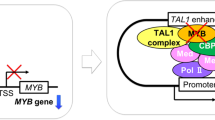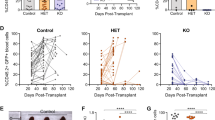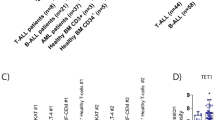Abstract
The transcription factor T-cell acute lymphocytic leukemia (TAL)-1 is a major T-cell oncogene associated with poor prognosis in T-cell acute lymphoblastic leukemia (T-ALL). TAL1 binds histone deacetylase 1 and incubation with histone deacetylase inhibitors (HDACis) promotes apoptosis of leukemia cells obtained from TAL1 transgenic mice. Here, we show for the first time that TAL1 protein expression is strikingly downregulated upon histone deacetylase inhibition in T-ALL cells. This is due to decreased TAL1 gene transcription in cells with native TAL1 promoter, and due to impaired TAL1 mRNA translation in cells that harbor the TAL1d microdeletion and consequently express TAL1 under the control of the SCL/TAL1 interrupting locus (SIL) promoter. Notably, HDACi-triggered apoptosis of T-ALL cells is significantly reversed by TAL1 forced overexpression. Our results indicate that the HDACi-mediated apoptotic program in T-ALL cells is partially dependent on their capacity to downregulate TAL1 and provide support for the therapeutic use of HDACi in T-ALL.
This is a preview of subscription content, access via your institution
Access options
Subscribe to this journal
Receive 12 print issues and online access
$259.00 per year
only $21.58 per issue
Buy this article
- Purchase on Springer Link
- Instant access to full article PDF
Prices may be subject to local taxes which are calculated during checkout





Similar content being viewed by others
References
Herblot S, Steff AM, Hugo P, Aplan PD, Hoang T . SCL and LMO1 alter thymocyte differentiation: inhibition of E2A-HEB function and pre-T alpha chain expression. Nat Immunol 2000; 1: 138–144.
Pike-Overzet K, de Ridder D, Weerkamp F, Baert MR, Verstegen MM, Brugman MH et al. Ectopic retroviral expression of LMO2, but not IL2Rgamma, blocks human T-cell development from CD34+ cells: implications for leukemogenesis in gene therapy. Leukemia 2007; 21: 754–763.
Bash RO, Hall S, Timmons CF, Crist WM, Amylon M, Smith RG et al. Does activation of the TAL1 gene occur in a majority of patients with T-cell acute lymphoblastic leukemia? A pediatric oncology group study. Blood 1995; 86: 666–676.
Ferrando AA, Neuberg DS, Staunton J, Loh ML, Huard C, Raimondi SC et al. Gene expression signatures define novel oncogenic pathways in T cell acute lymphoblastic leukemia. Cancer Cell 2002; 1: 75–87.
Chen Q, Cheng JT, Tasi LH, Schneider N, Buchanan G, Carroll A et al. The tal gene undergoes chromosome translocation in T cell leukemia and potentially encodes a helix-loop-helix protein. EMBO J 1990; 9: 415–424.
Begley CG, Aplan PD, Davey MP, Nakahara K, Tchorz K, Kurtzberg J et al. Chromosomal translocation in a human leukemic stem-cell line disrupts the T-cell antigen receptor delta-chain diversity region and results in a previously unreported fusion transcript. Proc Natl Acad Sci USA 1989; 86: 2031–2035.
Fitzgerald TJ, Neale GA, Raimondi SC, Goorha RM . c-tal, a helix-loop-helix protein, is juxtaposed to the T-cell receptor-beta chain gene by a reciprocal chromosomal translocation: t(1;7)(p32;q35). Blood 1991; 78: 2686–2695.
Aplan PD, Raimondi SC, Kirsch IR . Disruption of the SCL gene by a t(1;3) translocation in a patient with T cell acute lymphoblastic leukemia. J Exp Med 1992; 176: 1303–1310.
Francois S, Delabesse E, Baranger L, Dautel M, Foussard C, Boasson M et al. Deregulated expression of the TAL1 gene by t(1;5)(p32;31) in patient with T-cell acute lymphoblastic leukemia. Genes Chromosomes Cancer 1998; 23: 36–43.
Aplan PD, Lombardi DP, Reaman GH, Sather HN, Hammond GD, Kirsch IR . Involvement of the putative hematopoietic transcription factor SCL in T-cell acute lymphoblastic leukemia. Blood 1992; 79: 1327–1333.
Ferrando AA, Herblot S, Palomero T, Hansen M, Hoang T, Fox EA et al. Biallelic transcriptional activation of oncogenic transcription factors in T-cell acute lymphoblastic leukemia. Blood 2004; 103: 1909–1911.
Kelliher MA, Seldin DC, Leder P . Tal-1 induces T cell acute lymphoblastic leukemia accelerated by casein kinase IIalpha. EMBO J 1996; 15: 5160–5166.
Aplan PD, Jones CA, Chervinsky DS, Zhao X, Ellsworth M, Wu C et al. An scl gene product lacking the transactivation domain induces bony abnormalities and cooperates with LMO1 to generate T-cell malignancies in transgenic mice. EMBO J 1997; 16: 2408–2419.
O’Neil J, Billa M, Oikemus S, Kelliher M . The DNA binding activity of TAL-1 is not required to induce leukemia/lymphoma in mice. Oncogene 2001; 20: 3897–3905.
O’Neil J, Shank J, Cusson N, Murre C, Kelliher M . TAL1/SCL induces leukemia by inhibiting the transcriptional activity of E47/HEB. Cancer Cell 2004; 5: 587–596.
Leroy-Viard K, Vinit MA, Lecointe N, Jouault H, Hibner U, Romeo PH et al. Loss of TAL-1 protein activity induces premature apoptosis of Jurkat leukemic T cells upon medium depletion. EMBO J 1995; 14: 2341–2349.
Bernard M, Delabesse E, Novault S, Hermine O, Macintyre EA . Antiapoptotic effect of ectopic TAL1/SCL expression in a human leukemic T-cell line. Cancer Res 1998; 58: 2680–2687.
Park ST, Nolan GP, Sun XH . Growth inhibition and apoptosis due to restoration of E2A activity in T cell acute lymphoblastic leukemia cells. J Exp Med 1999; 189: 501–508.
Schrump DS . Cytotoxicity mediated by histone deacetylase inhibitors in cancer cells: mechanisms and potential clinical implications. Clin Cancer Res 2009; 15: 3947–3957.
Nakagawa M, Oda Y, Eguchi T, Aishima S, Yao T, Hosoi F et al. Expression profile of class I histone deacetylases in human cancer tissues. Oncol Rep 2007; 18: 769–774.
Glaser KB, Staver MJ, Waring JF, Stender J, Ulrich RG, Davidsen SK . Gene expression profiling of multiple histone deacetylase (HDAC) inhibitors: defining a common gene set produced by HDAC inhibition in T24 and MDA carcinoma cell lines. Mol Cancer Ther 2003; 2: 151–163.
Peart MJ, Smyth GK, van Laar RK, Bowtell DD, Richon VM, Marks PA et al. Identification and functional significance of genes regulated by structurally different histone deacetylase inhibitors. Proc Natl Acad Sci USA 2005; 102: 3697–3702.
Hsu HL, Wadman I, Baer R . Formation of in vivo complexes between the TAL1 and E2A polypeptides of leukemic T cells. Proc Natl Acad Sci USA 1994; 91: 3181–3185.
Bernard M, Delabesse E, Smit L, Millien C, Kirsch IR, Strominger JL et al. Helix-loop-helix (E2-5, HEB, TAL1 and Id1) protein interaction with the TCRalphadelta enhancers. Int Immunol 1998; 10: 1539–1549.
Tanaka A, Itoh F, Itoh S, Kato M . TAL1/SCL relieves the E2-2-mediated repression of VEGFR2 promoter activity. J Biochem 2009; 145: 129–135.
Hsu HL, Huang L, Tsan JT, Funk W, Wright WE, Hu JS et al. Preferred sequences for DNA recognition by the TAL1 helix-loop-helix proteins. Mol Cell Biol 1994; 14: 1256–1265.
Huang S, Brandt SJ . mSin3A regulates murine erythroleukemia cell differentiation through association with the TAL1 (or SCL) transcription factor. Mol Cell Biol 2000; 20: 2248–2259.
Wen J, Huang S, Pack SD, Yu X, Brandt SJ, Noguchi CT . Tal1/SCL binding to pericentromeric DNA represses transcription. J Biol Chem 2005; 280: 12956–12966.
Nimmanapalli R, Fuino L, Bali P, Gasparetto M, Glozak M, Tao J et al. Histone deacetylase inhibitor LAQ824 both lowers expression and promotes proteasomal degradation of Bcr-Abl and induces apoptosis of imatinib mesylate-sensitive or -refractory chronic myelogenous leukemia-blast crisis cells. Cancer Res 2003; 63: 5126–5135.
Krishnan M, Singh AB, Smith JJ, Sharma A, Chen X, Eschrich S et al. HDAC inhibitors regulate claudin-1 expression in colon cancer cells through modulation of mRNA stability. Oncogene 2010; 29: 305–312.
Yamaguchi K, Lantowski A, Dannenberg AJ, Subbaramaiah K . Histone deacetylase inhibitors suppress the induction of c-Jun and its target genes including COX-2. J Biol Chem 2005; 280: 32569–32577.
Silva A, Yunes JA, Cardoso BA, Martins LR, Jotta PY, Abecasis M et al. PTEN posttranslational inactivation and hyperactivation of the PI3K/Akt pathway sustain primary T cell leukemia viability. J Clin Invest 2008; 118: 3762–3774.
Amendola M, Venneri MA, Biffi A, Vigna E, Naldini L . Coordinate dual-gene transgenesis by lentiviral vectors carrying synthetic bidirectional promoters. Nat Biotechnol 2005; 23: 108–116.
Barata JT, Silva A, Brandao JG, Nadler LM, Cardoso AA, Boussiotis VA . Activation of PI3K is indispensable for interleukin 7-mediated viability, proliferation, glucose use, and growth of T cell acute lymphoblastic leukemia cells. J Exp Med 2004; 200: 659–669.
Silva A, Jotta PY, Silveira AB, Ribeiro D, Brandalise SR, Yunes JA et al. Regulation of PTEN by CK2 and Notch1 in primary T-cell acute lymphoblastic leukemia: rationale for combined use of CK2- and gamma-secretase inhibitors. Haematologica 2010; 95: 674–678.
Tsapis M, Lieb M, Manzo F, Shankaranarayanan P, Herbrecht R, Lutz P et al. HDAC inhibitors induce apoptosis in glucocorticoid-resistant acute lymphatic leukemia cells despite a switch from the extrinsic to the intrinsic death pathway. Int J Biochem Cell Biol 2007; 39: 1500–1509.
Cha TL, Chuang MJ, Wu ST, Sun GH, Chang SY, Yu DS et al. Dual degradation of aurora A and B kinases by the histone deacetylase inhibitor LBH589 induces G2-M arrest and apoptosis of renal cancer cells. Clin Cancer Res 2009; 15: 840–850.
Januchowski R, Dabrowski M, Ofori H, Jagodzinski PP . Trichostatin A down-regulate DNA methyltransferase 1 in Jurkat T cells. Cancer Lett 2007; 246: 313–317.
Fandy TE, Shankar S, Ross DD, Sausville E, Srivastava RK . Interactive effects of HDAC inhibitors and TRAIL on apoptosis are associated with changes in mitochondrial functions and expressions of cell cycle regulatory genes in multiple myeloma. Neoplasia 2005; 7: 646–657.
Siavoshian S, Segain JP, Kornprobst M, Bonnet C, Cherbut C, Galmiche JP et al. Butyrate and trichostatin A effects on the proliferation/differentiation of human intestinal epithelial cells: induction of cyclin D3 and p21 expression. Gut 2000; 46: 507–514.
Pokholok DK, Harbison CT, Levine S, Cole M, Hannett NM, Lee TI et al. Genome-wide map of nucleosome acetylation and methylation in yeast. Cell 2005; 122: 517–527.
Bernard O, Azogui O, Lecointe N, Mugneret F, Berger R, Larsen CJ et al. A third tal-1 promoter is specifically used in human T cell leukemias. J Exp Med 1992; 176: 919–925.
Delabesse E, Bernard M, Landman-Parker J, Davi F, Leboeuf D, Varet B et al. Simultaneous SIL-TAL1 RT-PCR detection of all tal(d) deletions and identification of novel tal(d) variants. Br J Haematol 1997; 99: 901–907.
Kawamata N, Chen J, Koeffler HP . Suberoylanilide hydroxamic acid (SAHA; vorinostat) suppresses translation of cyclin D1 in mantle cell lymphoma cells. Blood 2007; 110: 2667–2673.
Bernhard D, Ausserlechner MJ, Tonko M, Loffler M, Hartmann BL, Csordas A et al. Apoptosis induced by the histone deacetylase inhibitor sodium butyrate in human leukemic lymphoblasts. FASEB J 1999; 13: 1991–2001.
Batova A, Shao LE, Diccianni MB, Yu AL, Tanaka T, Rephaeli A et al. The histone deacetylase inhibitor AN-9 has selective toxicity to acute leukemia and drug-resistant primary leukemia and cancer cell lines. Blood 2002; 100: 3319–3324.
Moreno DA, Scrideli CA, Cortez MA, de Paula Queiroz R, Valera ET, da Silva Silveira V et al. Differential expression of HDAC3, HDAC7 and HDAC9 is associated with prognosis and survival in childhood acute lymphoblastic leukaemia. Br J Haematol 2010; 150: 665–673.
Dokmanovic M, Clarke C, Marks PA . Histone deacetylase inhibitors: overview and perspectives. Mol Cancer Res 2007; 5: 981–989.
You JS, Kang JK, Lee EK, Lee JC, Lee SH, Jeon YJ et al. Histone deacetylase inhibitor apicidin downregulates DNA methyltransferase 1 expression and induces repressive histone modifications via recruitment of corepressor complex to promoter region in human cervix cancer cells. Oncogene 2008; 27: 1376–1386.
Aplan PD, Lombardi DP, Kirsch IR . Structural characterization of SIL, a gene frequently disrupted in T-cell acute lymphoblastic leukemia. Mol Cell Biol 1991; 11: 5462–5469.
Acknowledgements
We are grateful to the patients and their families who have generously contributed to this study. We thank Dr Nuno R dos Santos for kindly providing the PF382 cell line used in this study. This work was supported by grants from Children with Leukaemia Charity, UK, and from Fundação para a Ciência e a Tecnologia, FCT, Portugal (PTDC/SAU-OBD/69974 and 104816); BAC and SFdA had FCT SFRH PhD and postdoctoral fellowships, respectively. ABAL had a PhD fellowship from FAPESP.
Author information
Authors and Affiliations
Corresponding author
Ethics declarations
Competing interests
The authors declare no conflict of interest.
Additional information
Supplementary Information accompanies the paper on the Leukemia website
Supplementary information
Rights and permissions
About this article
Cite this article
Cardoso, B., de Almeida, S., Laranjeira, A. et al. TAL1/SCL is downregulated upon histone deacetylase inhibition in T-cell acute lymphoblastic leukemia cells. Leukemia 25, 1578–1586 (2011). https://doi.org/10.1038/leu.2011.140
Received:
Accepted:
Published:
Issue Date:
DOI: https://doi.org/10.1038/leu.2011.140
Keywords
This article is cited by
-
Targeting cancer cell plasticity by HDAC inhibition to reverse EBV-induced dedifferentiation in nasopharyngeal carcinoma
Signal Transduction and Targeted Therapy (2021)
-
MiR-146b negatively regulates migration and delays progression of T-cell acute lymphoblastic leukemia
Scientific Reports (2016)
-
An immediate transcriptional signature associated with response to the histone deacetylase inhibitor Givinostat in T acute lymphoblastic leukemia xenografts
Cell Death & Disease (2016)
-
Stem Cell Leukemia: how a TALented actor can go awry on the hematopoietic stage
Leukemia (2016)
-
FOXP3 can modulate TAL1 transcriptional activity through interaction with LMO2
Oncogene (2016)



